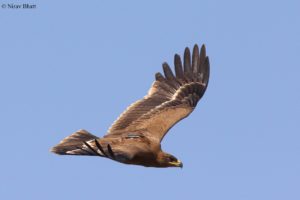Steppe eagles [2022]
Long-term study sheds light on Steppe eagle migration
 It’s a rough, but mostly routine, journey for Steppe eagles (Aquila nipalensis) migrating to their winter abodes, according to results of a four-year study. In May 2022 Russia-based ornithologists announced the results of a conservation project launched in 2018 that centered on the Steppe eagle and focused on necessary measures to preserve the species. Researchers conducted the study, aimed at identifying important migration routes, identifying threats to the birds, and developing conservation measures, by monitoring 20 Steppe eagles from 2018-2022.
It’s a rough, but mostly routine, journey for Steppe eagles (Aquila nipalensis) migrating to their winter abodes, according to results of a four-year study. In May 2022 Russia-based ornithologists announced the results of a conservation project launched in 2018 that centered on the Steppe eagle and focused on necessary measures to preserve the species. Researchers conducted the study, aimed at identifying important migration routes, identifying threats to the birds, and developing conservation measures, by monitoring 20 Steppe eagles from 2018-2022.
Steppe eagles, like other raptors, are an indicator of a region’s ecological health. These indicator species, usually predators, are at the top of the food chain and thus extremely sensitive to environmental poisons, habitat loss, climate change and other factors. With a wingspan of 5-6 or more feet wide (165-193 cm), these eagles live and migrate in the heart of the Eurasian continent. They feed mainly on rodents in open ranges and grasslands, but can be found in mountainous areas and even urban settings. They are the only eagle species to build their nests primarily on the ground. Nesting occurs at the northern end of their range in Central Asia and Russia.
GPS “backpacks”
For the study, Steppe eagle participants were tagged in their nesting areas with special GPS/GSM tracking device “backpacks.” These trackers do not interfere with the birds’ flying or hunting. Unfortunately, out of the initial group, only 13 were confirmed alive when the study concluded in May 2022: four died from electrocution on power lines, one was killed by poachers, and connection with the trackers on two Steppe eagles disappeared, fate unknown.
From the study, researchers gained valuable information about how Steppe eagles cope with migrating to their winter grounds. Juveniles choose a variety of migration routes; however, as the birds mature, they opt for the shortest, safest, and most direct route to overwintering and back. Such routes mainly pass through mountain ranges and sparsely populated areas where there are few roads and power lines. This tactic helps birds avoid human-related dangers: power lines where birds die from electrocution, poachers, and other threats. Unchecked human-driven development and habitat destruction have reduced the number of safe migration corridors for Steppe eagles.
Migration
Based on the behavior of five Steppe eagles born in 2021, ornithologists also gleaned insight into the habits of young birds. All five successfully reached their winter destinations; nonetheless, when spring arrived, none were in a hurry to return to Russia, delaying their journey back to their summer homes.
Knowing exact routes, places that pose high risk of fatality, and primary threats helps researchers fill in knowledge gaps regarding Steppe eagle migration and develop effective conservation measures. Tracking data obtained from the four-year study will contribute to international action plans for the conservation of the Steppe Eagle, being developed and updated by ornithologists worldwide.
Learn more about our raptor conservation work.
Dwindling numbers
These eagles’ annual migration to their wintering grounds takes them to nearby Turkmenistan and Uzbekistan, but also as far as India, Africa, and the Middle East. The International Union for the Conservation of Nature (IUCN) lists the Steppe eagle as endangered. As the graphic shows, the number of Steppe eagles worldwide has plummeted. Over the past 25 years, populations have decreased by an alarming 85 percent.
This infographic shows numbers of Steppe eagles in Russia, noting that over the past 25 years, populations have decreased by a whopping 85 percent. In 1995, there were more than 25,000 nesting pairs. By 2000, that number had plummeted to just over 5,000 pairs. In 2018, Steppe eagle populations in Russia had fallen to an estimated 2,640 to 3,945 pairs.
Measures for saving the Steppe eagle
- End the use of poisons for rodent control
- Create protected territories in nesting areas
- Educate local populations and instill a desire to protect raptors
- Ensure electric power line safety
- Combat poaching
